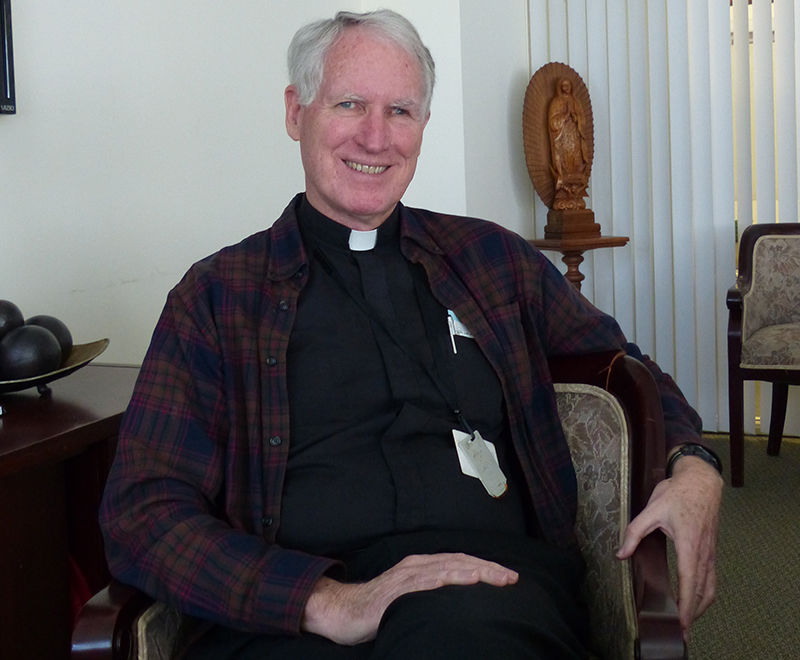What comes to mind when one thinks of Tai Chi meditation, Pal Dan Gum exercises, visualization, energy tapping modalities and other seemingly self-absorbed SoCal practices?
In La La Land, there’s a lot to choose from.
Perhaps it’s downtown gentrified young males whose five-star gyms offer these sidebars on top of muscle-stretching machines.
Or better yet, what about bored Pacific Palisades housewives who need a respite from Instagram — never mind having to pile the kids into the mini-van after school for soccer practice, AP calculus tutoring and JV water polo games across town?
Yet there’s more to meditation than you might think.
Since 2009, Father George Horan has ministered a program called “Capacitar,” started by a former nun from Santa Cruz named Patricia Cane. She travels the globe offering ancient meditation practices to some of the most traumatized victims of violence, war and natural disasters.
The vision is simply to heal that world. How? By using a “hands-on popular education approach,” teaching simple wellness practices leading to health, wholeness and peace in troubled individuals. And this, in turn, will lead to solidarity, understanding and reconciliation.
In 2008, Father Horan, then co-director of the Los Angeles Archdiocese’s Detention Ministry (since renamed the Office of Restorative Justice) and fellow worker Rita Chavez signed up for a four-weekend course to learn the ins and outs of Capacitar.
“And just two or three hours into the first day of training, we realized that everybody in our ministry needed this,” the 69-year-old priest reports. “Doing this kind of work [in jails, prisons and juvenile facilities] we really needed it. And we started noticing some changes just in that weekend in ourselves.
“I’ve had pain in my shoulders for years that I knew was from stress, and by the end of the weekend, it was gone,” he says. “That really convinced me.”
The next year he went to Israel to join Cane, and has been back every year since, doing a lot of work in Palestinian refugee camps. “It just seems like it really helped these people dealing with so much trauma,” he says.
Afghan ministry
Seeing a similar need in war-torn Afghanistan, the priest and Cane did workshops there last spring and this year from mid-February through March 5. Through connections with the Afghan Cultural Center and Afghan Peace Volunteers, they met groups of mostly young people whose families have suffered through decades of constant conflict. The results have been positive.
“I have fallen in love with the people of this country that I have had the opportunity to meet and work with,” he wrote home in an email during his initial visit. “Their courage and dedication to nonviolence is inspiring. Their president was recently in Washington, D.C., and said that everyone in his country is traumatized, and he invited the people of the U.S. to help in healing the trauma.
“It has been amazing to see the changes in folks here after a few simple workshops. One of the members of the Afghan Peace Volunteers’ women’s community said that she slept through the night for the first time in a long time after our afternoon session with them.”
Sadly, he also noted “no one is addressing the trauma healing that is needed in Afghanistan, and, without that deeper healing, Afghanistan cannot move forward. However, most Afghans are suspect of Western psychology; there are few psychologists and psychiatrists in the country; no counselors are being trained at the university level; and trauma treatment, if available, focuses on talk therapy and medication, rather than addressing the systemic trauma of the society.”
These troubling conditions make the middle-eastern nation — which suffered 3,545 civilian deaths and 7,487 injured in 2015 — fertile ground for Capacitar’s hands-on body-mind-spirit healing practices.
Tai chi, originally conceived as a Chinese marshal art, is now also practiced for health benefits and longevity. Capacitar’s version is condensed, but with movements still flowing into one another. Pal Dan Gum exercises have been used for the curing of diseases and promotion of good health also for thousands of years in China and Korea.
Other practices include simple finger holds for managing emotions (think of a baby sucking his thumb), a seated legs-stretched-out movement called “switching,” along with visualization relaxation, contemplation and deep breathing.
‘I’ve see it happen’
Father Horan, who still works for the Office of Restorative Justice, but not as co-director, has also adopted the relaxation practices locally for inmates in Men’s Central Jail and California prisons, plus Los Angeles County-USC General Hospital. And he recently started a nonprofit called “Healing Hearts Restoring Hope.”
So do these techniques really work? Or are they New Age malarkey?
When asked, the priest, who was ordained in 1972, smiles. “You know, I’ve seen it happen,” he says. “And it’s kind of an immediate change. I mean, an immediate relief from some of the stuff going on inside them.”
Then he talks about a prisoner at Men’s Central he’s helped do imaginative contemplation with a group. The guy came up to him after and said, “This is the first time my mind has quieted down that I can remember. Things look very different now. I’ve been able to clear things out.”
After a moment, with a semi-quizzical look, Father Horan says, “I don’t know how it all works. I just know that it does. And there’s been studies done in universities. They have all the technical stuff about why it does work. But I just know that it does.
“So I don’t care why it works,” he points out. “It really is helpful for people who are suffering from stress and trauma.”
Healing Hearts Restoring Hope
For more information, contact Father George Horan at [email protected]; (323) 251-9016; Healing Hearts Restoring Hope, 135 North Mission Rd., Los Angeles, CA 90033; Rita Chavez, HHRH program coordinator, [email protected], (323) 496-4329; or Sister Sue Reif, HHRH executive director, [email protected], (323) 685-2065.

